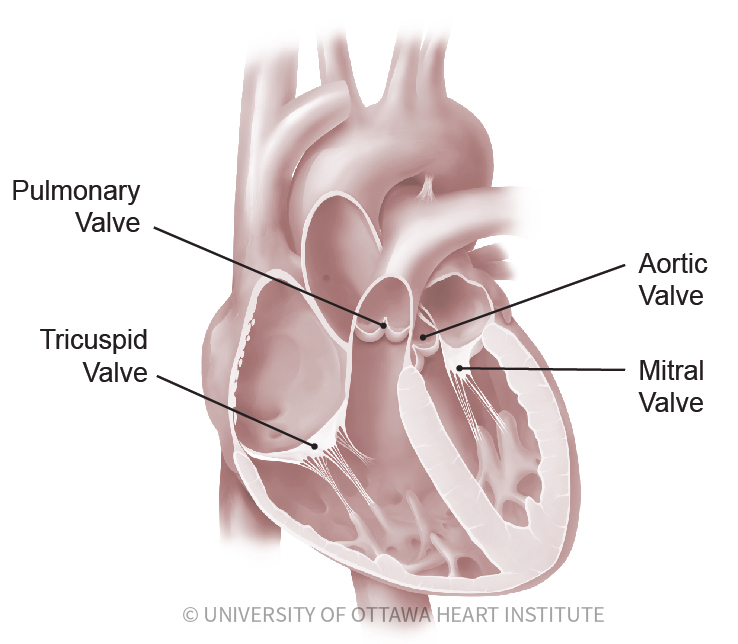
What Is Heart Valve Disease?
The heart has four valves, each located at the exit of one of the heart’s four chambers. As the heartbeat pushes blood through the heart, the valves close after blood has entered the chamber to prevent it from leaking backward.
Sometimes, a valve may not open properly. This is a condition called valvular stenosis. Stenosis can occur because the valve opening is too small or because the parts of the valve that open (called the leaflets) become stiff or stick together. With valvular stenosis, the heart has to work harder to push a normal volume of blood through the body.
In a condition called valvular insufficiency, a valve does not close completely. Sometimes, the valve bulges back into the previous chamber of the heart (called valve prolapse). When a valve does not close completely, blood leaks backwards into the previous chamber. Valvular insufficiency, like valvular stenosis, causes the heart to work harder.
If left untreated, heart valve disease can lead to other heart problems, including arrhythmias, stroke, pulmonary hypertension or heart failure.
On this page
Causes
Sometimes heart valve disease is congenital—that is, a person is born with the condition. Some cases of heart valve disease are caused by normal wear and tear on the heart valves, which open and close hundreds of thousands of times each day. Other heart diseases or disorders can contribute to heart valve disease by causing scarring or thickening of heart tissue, including:
Some infections can also cause heart valve disease by scarring and damaging the valve leaflets. Examples include rheumatic fever, which was common before the widespread use of antibiotics, and endocarditis, an infection of the lining of the heart. Once valves have been damaged by endocarditis, they are more vulnerable to re-infection.
Diagnosis
Tests commonly used to diagnose heart valve disease include:
- Echocardiogram: to assess anatomy, valve function, and blood flow through the heart
- Electrocardiogram: to identify problems with heart rhythm
- Chest X-rays: to look at the size and shape of the heart
- Coronary catheterization: to identify blocked or restricted blood vessels
- Exercise Stress Test: to measure how well the heart functions when challenged to work harder than normal
- Magnetic resonance imaging (MRI): to take detailed pictures of the heart’s chambers and blood vessels
Symptoms
Sometimes heart valve disease does not cause any symptoms. The only indication may be a heart murmur that can be heard through a stethoscope. Symptoms of heart valve disease can include:
- Shortness of breath, especially during exercise or when lying down
- Dizziness or fainting
- Chest pain or pressure
- Heart palpitations (a racing heartbeat)
- Weakness or tiredness
- Swelling of the feet, ankles, or abdomen
Many of these symptoms can be confused with less serious conditions, the effects of aging or physical inactivity. They can also be confused with other diseases affecting the heart or lungs.
The severity of symptoms does not always correlate with the severity of the heart valve disease. Some people with mild symptoms may need treatment immediately to prevent further heart damage
Treatments
In many cases, the symptoms of heart valve disease can be managed with drugs, but eventually the valves may need to be surgically repaired or replaced. There are many treatment options available for any one type of heart valve disease. Only a trained specialist can determine the appropriate method for any particular case.
Medication Therapies
Many medications are available for reducing the symptoms of heart valve disease. These include drugs to:
- Lower blood pressure (ACE inhibitors or angiotensin receptor blockers)
- Slow the heartbeat (beta blockers)
- Keep the heart rhythm normal (anti-arrhythmic drugs)
- Dilate (open) the blood vessels
- Help prevent blood clots (anticoagulants and blood thinners)
- Remove excess fluid in the body (diuretics)
Surgery
Heart valve surgery may be needed to repair or replace a defective valve that might otherwise cause damage to the rest of the heart. If repair is possible, it is preferred over replacement because a repaired valve is stronger than a replacement valve.
Catheter-based Procedures
These procedures offer less invasive alternatives for patients who are not eligible for surgery.
-
MitraClip: In the MitraClip procedure, a clip is inserted through a catheter and is attached to the mitral valve leaflets, fastening them firmly together and allowing the valve to close better.
-
Transcatheter Aortic Valve Implantation (TAVI): In the TAVI procedure, a replacement valve is inserted through a catheter and implanted inside the existing aortic valve.
Lifestyle Changes
People with any type of heart valve disease can benefit from reducing salt in the diet to help lower blood pressure, and reducing intake of fat and cholesterol. If a patient is overweight, losing weight can help relieve some of the symptoms of heart valve disease by reducing the burden on the heart. Patients with any type of heart disease who smoke should quit smoking. Smoking-cessation aids are available to patients who find it difficult to quit on their own.
Risk Factors and Prevention
Some risk factors for developing heart valve disease are the same as other heart conditions and can be reduced with lifestyle changes or with early detection and medication. To prevent heart disease in general, it is important to:
- Quit smoking
- Get your cholesterol checked and under control
- Eat a healthy diet
- Exercise regularly
- Lose weight if you are overweight

